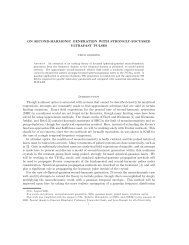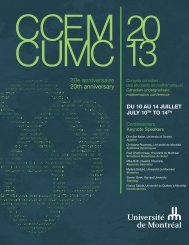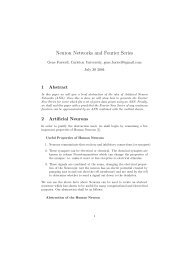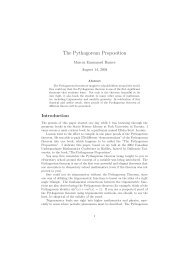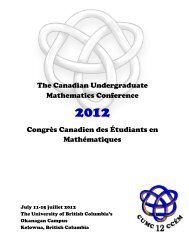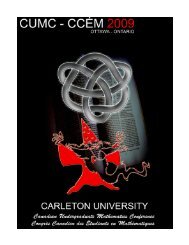booklet - CUMC - Canadian Mathematical Society
booklet - CUMC - Canadian Mathematical Society
booklet - CUMC - Canadian Mathematical Society
Create successful ePaper yourself
Turn your PDF publications into a flip-book with our unique Google optimized e-Paper software.
INTRODUCTION AUX NOMBRES DE BERNOULLIFRANCIS RODRIGUELes nombres de Bernoulli sont des nombres rationnels importants en théorie desnombres. Nous montrerons comment ceux-ci sont liés à la somme 1 m + 2 m + ... + n mpour n, m ∈ N généralisant la formule bien connue 1 + 2 + ... + n = n(n+1)2. Ensuite,nous prouverons que ces nombres sont liés aux valeurs paires de la fonction zeta deRiemmann. Nous conclurons sur une généralisation de ces derniers.A NEURAL NETWORK APPROACH FOR SOLVING THE LINEAR BILEVEL PROGRAM-MING PROBLEMGARRETT PALUCKIn this talk, we will present a neural network approach for solving the linear bilevelprogramming problem. We will show that the neural network is Lyapunov stable andcapable of generating the optimal solution to the linear bilevel programming problem.We will give numerical results that show that the neural network approach is feasibleand efficient.UN ARCHET ET DU SABLE OU COMMENT PERTURBER UN EMPEREURHÉLÈNE PÉLOQUIN-TESSIERQu’est-ce qui peut bien relier de mystérieux motifs à 3000 francs, une certaine SophieGermain et l’honorable Gauss? Une bonne histoire bien sûr! L’histoire du débutde la géométrie spectrale mettant notamment en vedette le grand empereur Napoléon.Au cours de cet exposé tout en images, nous discuterons de tambours, d’équations auxdérivées partielles, de géométrie et – de théorie des nombres, pourquoi pas? En étudiantles vibrations d’un exotique tambour carré, nous verrons comment il est possibled’atterrir sur le probléme du cercle de Gauss, un problème encore ouvert.THREE PLAYER ENVY-FREE CAKE CUTTINGIFAZ KABIRThe two player cake cutting problem has a very elegant solution - the first playercuts the cake into two pieces that he values equally, and then the second player choosesone of the pieces. This way the first player is not jealous of the second player’s piecesince he valued the two pieces equally, and the second player is not jealous of the fistplayer’s piece since he picked the piece that he valued the most. Unfortunately, thistechnique does not generalize to 3 players. In this talk I’ll show a solution for the3 player case under some mild assumptions using a constructive proof of Sperner’sLemma.28



